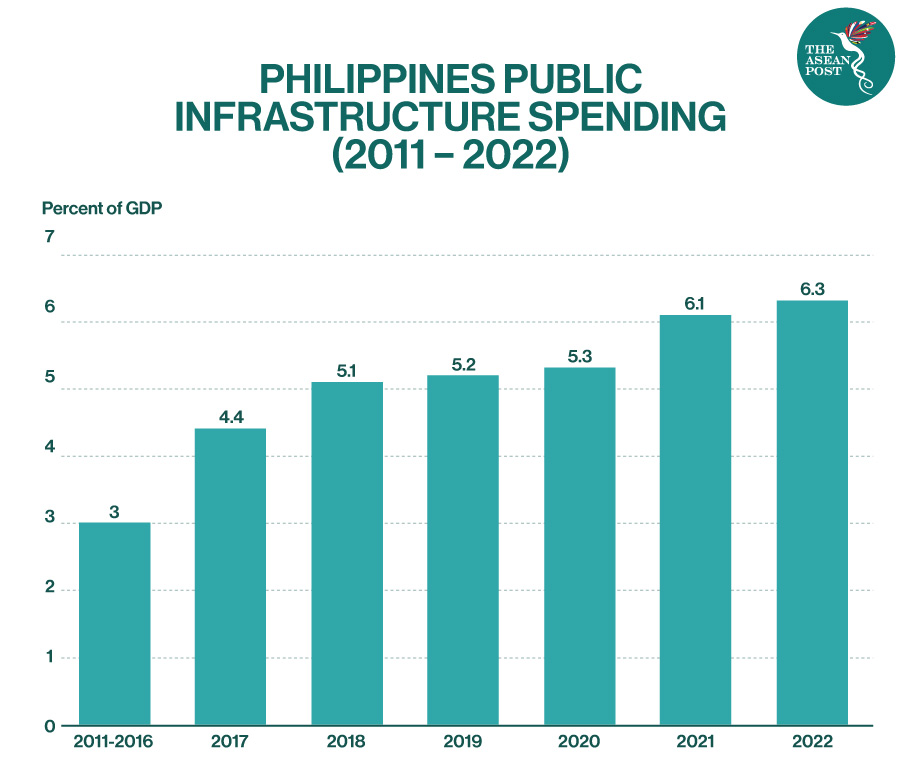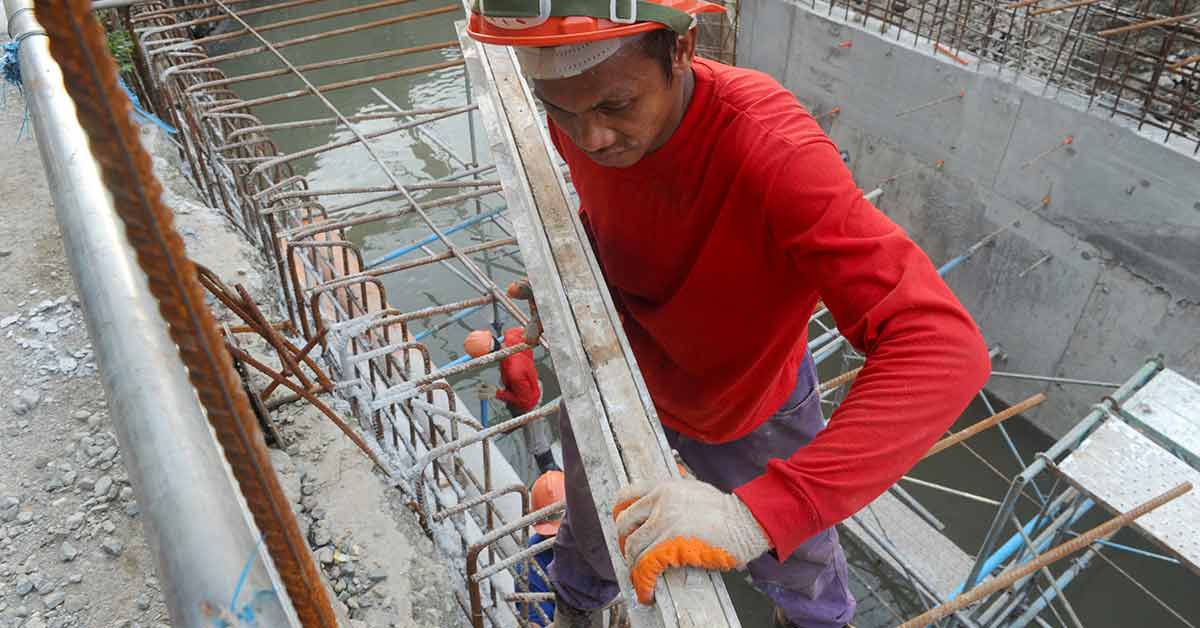Amidst the economic recession being experienced by the Philippines and the world at large caused by the COVID-19 pandemic, infrastructure development through the “Build Build Build” (BBB) program of the Duterte administration is said to be one of the key drivers if not the main driver of the economic recovery of the country.
The “BBB” program is anchored on Duterte’s long-time conviction and advocacy for a more balanced and responsive regional/countryside development for the country. He stressed that the only solution to address the worsening congestion and traffic situation in Metro Manila and the skewed development favouring Metro Manila and the traditional urban centres of the country is through the dispersion of economic activities. And this is the compelling reason why his administration is accelerating infrastructure development before his term ends even during the current COVID-19 pandemic.
The BBB Program
The “BBB” program consists of around 20,000 infrastructure projects nationwide, involving roads, highways, farm-to-market roads, airports, seaports, terminals, evacuation centres, lighthouses, hospitals, schools, government centres, and the like. It is the centrepiece and one of the top-priority programs of the Duterte administration, which has been allocated a budget of around PHP 8 trillion (US$164.7 billion) for a six-year period (2017-2022). Such budget allocation on infrastructure is thus far the highest in Philippine history to date.
Over the past six administrations, the country’s infrastructure spending-to-Gross Domestic Product (GDP) ratio only averaged at 2.6 percent of GDP. To note, from 2001 to 2010, the average percentage of infrastructure budget to GDP was 1.6 percent or PHP 100.3 billion (US$2.06 billion), while from 2011-2016 it was 3.0 percent or PHP 378.3 billion (US$7.7 billion).
When Duterte took office in July 2016, his administration reversed this “long-neglect” in infrastructure investment. To cite, from 2017 to 2019, the average percentage of infrastructure budget to GDP was 6.0 percent or PHP 932 billion (US$19.1 billion). In 2020 the budget allocation for the “BBB” program was 4.6 percent of GDP or PHP 972.5 billion (US$20 billion).
Hence, these numbers indicate a far more augmented budget for infrastructure development compared to the previous administration; illustrating the fervent resolve of the Duterte administration to not only accelerate infrastructure development but to deliver the much-needed infrastructure projects to bridge the infrastructure gap in the country.

One has to take cognisance of the fact that, the lack of infrastructure development in the Philippines has long been pointed out to be the “chink in the armour” or one of the “weakest links” in the overall economic development of the Philippines.
Setbacks
The “BBB” program has encountered some setbacks following the COVID-19 pandemic. One of the impacts was the realignment of part of the “BBB” budget to finance the government’s response to the health and socio-economic crises in the country.
For instance, the 2020 budget of the Department of Public Works and Highways (DPWH), one of the main implementing agencies of the “BBB” program, was sliced to fund dole-outs and medical response costing around PHP 121.9 billion (US$2.5 billion) leaving it with a much-lowered infrastructure program spending budget for 2020 at around PHP 458.9 billion (US$9.4 billion) down from PHP 580.9 billion (US$11.9 billion).
Also, the Department of Transportation (DOTr), another main implementing agency of “BBB” projects suffered a budget cut of around PHP 8.8 billion (US$181.2 million) from its original budget of around PHP147 billion (US$3.02 billion) this year.
However, despite budget cuts in public spending on infrastructure projects, the government has reprioritised the infrastructure program and retained 92 flagship projects amounting to around PHP 4.1 trillion (US$84.4 billion) in value.
Although eight projects were cut from the list of infrastructure priority projects, 13 more were added aimed at intensifying internet connectivity, organising water supply, and enhancing transportation, health care systems, and the digital economy in the country; including a Virology Institute in New Clark City to prepare for the next pandemic. The added infrastructure projects are said to be ready for implementation and are indeed responsive to the country’s post-pandemic needs.
BBB & Economic Recovery
Nevertheless, despite these setbacks, “BBB” projects were among the first major economic activities to resume operation in the Philippines.
Presidential Adviser for Flagship Programs Vivencio Dizon during the joint Development Budget Coordination Committee (DBCC) press conference a month ago said, “We have not only continued with “BBB” and our flagship projects, but we will also further intensify this to serve as a major driver in our recovery for the coming months.”
He further reiterated that infrastructure projects under the “BBB” program will help in the recovery of the economy that shrank for the second consecutive quarter and fuel economic growth in the coming months.
Based on DPWH data, it is estimated that the “BBB” program had created five million jobs from 2016 to 2019. It is estimated that it will generate more than 1.5 million jobs this year despite the pandemic. This to some extent, will help in stabilising and boosting economic activity in the country.
BBB Successes
Despite the lockdown and quarantine measures in the past few months due to the COVID-19 pandemic, a number of flagship infrastructure projects were completed. These include (1) the Angat Water Transmission Improvement Project; (2) the Tarlac-Pangasinan-La Union Expressway Rosario Exit; (3) the newly opened four-lane Sorsogon City Coastal Road; (4) New Clark City [Phase 1A]; (5) Harbor Link; (6) Sangley Airport; (7) Broadband project with Facebook [Luzon Bypass Infrastructure]; (8) Bohol-Panglao International Airport; (9) Laguna Lake Highway; (10) Cagayan de Oro Port, the country’s biggest passenger terminal port; (11) TPLEX Rosario; (12) TPLEX Pozorrubio; (13) New World-Class Terminal in Mactan-Cebu International Airport; (14) Lal-lo International Airport; and (15) Puerto Princesa International Airport.
Likewise, infrastructure developments for the domestic airports of Virac, Marinduque, Tuguegarao, San Vicente, and Busuanga in Luzon; Maasin, Tacloban, and Catarman in the Visayas; and Ipil, Camiguin, and Siargao in Mindanao, have also been completed.
In more than four years since the “BBB” program was launched in 2017, it has already built roads, bridges, classrooms, and flood control facilities among others, that to a considerable extent, have improved the lives of many Filipinos. To note, the “BBB” program was able to complete around 121 airport projects – 114 are ongoing and 75 are for procurement; 369 commercial, social, and tourism seaports – 108 are still in the process of completion; 23,657 kilometres of roads; and 4,959 bridges.
Since the end of 2019, the “BBB” program was also able to complete 71,803 classrooms across the country that has benefited more than 3.2 million students. A total of 4,536 flood mitigation structures were also completed to expand protected flood-prone areas across the country, while 82 evacuation centres were built by the DPWH in 52 provinces while 55 more are underway.
The construction of six railway projects is also underway, while additional railway projects are also in the pipeline. Once all the railway projects are completed, the number of stations across all railway systems will increase to 169 from 59, the number of trains to 1,425 from 221, and daily ridership to 3.26 million from 1.02 million. The international airports in Davao, General Santos, Zamboanga, Iloilo, Kalibo, and Laoag are also undergoing improvements.
Conclusion
The delivery and completion of “BBB” projects within the target timeframe under the current administration will not only steer and drive economic recovery of the country amid the pandemic and in the post-pandemic era, but will to some degree enhance, improve and further develop land, air, sea, and inter-island connectivity and mobility in the country.
This will also facilitate balanced development and to a greater extent diffuse economic activities and development from the urban centres of the country toward rural areas or the countryside. The transport-related infrastructure projects will not only ease traffic and road congestion in the National Capital Region (NCR) and other traditional urban areas like Metro Davao and Metro Cebu but will also facilitate the transporting of people and goods from one place/island to another.
The completion of all these infrastructure projects, in the long run, would not only to a greater extent, sustain, accelerate, and achieve the desired economic growth of the country but most importantly, will improve the Philippines’ global competitiveness.
Related Articles:
How The Philippines Is Fighting COVID-19
Can Duterte’s “Build! Build! Build!” Boost The Philippines’ Economy?

